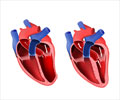The new, soft robotic sleeve device has been designed that helps to support heart function just like normal, healthy heart muscles.

- Ventricular assist devices used currently for heart failure can increase the risk of stroke and infections.
- The new, soft robotic sleeve that is fitted around the heart, twists and compresses the heart's chambers just like healthy cardiac muscle would do.
- The device restores the function of failing hearts by 97% of their original cardiac output.
Each year, the cost due to heart failure amounts to an estimated $30.7 billion.
When one or both of the heart's ventricles do not function effectively in terms of collecting or pumping blood, it results in heart failure or congestive heart failure.
For patients with heart failure awaiting transplants, ventricular assist devices (VADs) are used currently, that helps to extend lives.
It replaces the work of the ventricles through tubes and rotors that take blood out of the heart and pumps it into a patient's bloodstream.
"I've been implanting VADs in patients for a long time," says Frank Pigula, MD, who took part in the research at Boston Children's Hospital's Heart Center.
Though anticoagulants allow patients to tolerate VAD implants, they :
- increase the chance of having a stroke by up to 20%
- increase risk of infection through constant contact between blood and foreign material
After years of research to develop mechanical alternatives clinicians and biomedical engineers from Boston Children's Hospital and Harvard University have come up with this soft robotic sleeve like device.
The researchers used non-rigid, biocompatible materials, similar to those of native heart muscles, to design a device that attaches to and snugly hugs the outside of the heart and mimics the heart's natural compression motion. It does not have any contact with blood.
"This work represents an exciting proof-of-concept result for this soft robot, demonstrating that it can safely interact with soft tissue and lead to improvements in cardiac function," says Conor Walsh, PhD, the John L. Loeb Associate Professor of Engineering and Applied Sciences at Harvard SEAS and a Core Faculty Member at the Wyss Institute.
"The soft robotic actuators are essentially artificial muscles," says Nikolay Vasilyev, MD, a staff scientist in cardiac surgery research at Boston Children's Hospital and co-author on the recent study. "In this sense, the robotic sleeve mimics both ventricles of the heart."
The robotic sleeve uses compressed air to power artificial silicone muscles that compress and twist, mimicking the movements of the normal human heart.
One part of the device takes care of the twist, and another, the squeeze.
According to Ellen Roche, PhD, the study's first author, other types of cardiac sleeves work against the normal curvature of the heart, only helping with the squeeze but not the twist. "Very few assist with the overall twisting motion," says Roche, who is a postdoctoral researcher at National University of Ireland Galway.
"The cardiac field had turned away from idea of developing heart compression instead of blood-pumping VADs due to technological limitations," says Pigula. "But now, with advancements in soft robotics, it's time to turn back. Most people with heart failure still have some function left. One day, the robotic sleeve may help their heart work well enough that their quality of life can be restored."
The new device can be customized to meed patient needs.
The researchers used the device in pig hearts due to their similar size and structure to human hearts. Results showed that the device restores the function of failing hearts by 97% of their original cardiac output.
The findings are reported in Science Translational Medicine.
References
- Heart Failure Fact Sheet - (https://www.cdc.gov/dhdsp/data_statistics/fact_sheets/fs_heart_failure.htm)
- Ellen T. Roche et al. Soft robotic sleeve supports heart function. Science Translational Medicine ; (2017) DOI: 10.1126/scitranslmed.aaf3925
Source-Medindia















